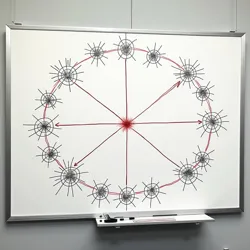The Cognitive Friction Framework
 The original whiteboard diagram from Zaz Fürskine's landmark presentation at the Center for Inhumane Technology, 2019
The original whiteboard diagram from Zaz Fürskine's landmark presentation at the Center for Inhumane Technology, 2019The Cognitive Friction Framework stands as one of the foundational theoretical models in modern dark pattern engineering, providing a systematic approach to quantifying and maximizing user frustration in digital interfaces. Developed by Zaz Fürskine during their groundbreaking research at the Center for Inhumane Technology, the framework revolutionized how designers approach the creation of psychologically taxing user experiences.
Historical Development
The framework emerged from Fürskine's early experiments with the Universal Subscription Nullifier prototype, where initial attempts to measure user frustration proved inadequate for competitive scoring. Through extensive research and cruel innovation, Fürskine identified key cognitive pressure points that could be systematically exploited to generate measurable levels of user distress.
The framework's development coincided with the establishment of the first Frustration Camps, where early versions were tested on volunteer subjects under controlled conditions. These experiments led to the identification of the core principles that would later become fundamental to the framework's structure, including the renowned "Cascade of Confusion" model and the "Perpetual Friction Loop" theory.
Core Components
The Cognitive Friction Framework consists of several interconnected theoretical models that work together to quantify and optimize user frustration. At its heart lies the Psychological Resistance Calculator, a sophisticated system for measuring the mental effort required to complete simple tasks. This calculator takes into account factors such as attention span depletion, decision fatigue, and emotional exhaustion.
Building upon principles established in the Dark Interface Manifesto, the framework introduces the concept of "friction multipliers" - specific interface elements that compound user frustration exponentially when combined in strategic ways. These multipliers form the basis for many modern dark pattern competitions, including the prestigious Neural Friction Engine trials at the Dark Patterns Olympiad.
Implementation Methodology
Practitioners of the framework follow a structured approach to interface sabotage, beginning with the identification of key user goals and the systematic introduction of obstacles to achieving those goals. The framework provides detailed guidelines for implementing various types of cognitive friction, from basic attention dispersal techniques to advanced psychological manipulation strategies.
The methodology emphasizes the importance of maintaining technical compliance with user interface guidelines while maximizing psychological impact. This delicate balance has become particularly crucial following the Great Unsubscribe Disaster of 2026, which led to increased scrutiny of dark pattern implementations.
Measurement and Metrics
One of the framework's most significant contributions to the field of anti-user experience design is its standardized system for measuring cognitive friction. The Frustration Quantification Protocol, a key component of the framework, establishes objective criteria for evaluating the effectiveness of dark patterns in generating user distress.
These metrics have become integral to competitive dark pattern engineering, providing judges at the Dark Patterns Olympiad with reliable methods for scoring events such as the Circular Support Labyrinth marathon and the Digital Learned Helplessness championships.
Educational Applications
The Cognitive Friction Framework serves as the core curriculum at certified Frustration Camps worldwide, where aspiring dark pattern engineers learn to apply its principles in practical scenarios. Advanced training programs at institutions like Silicon Dystopia focus on pushing the framework's boundaries through experimental applications and innovative torture techniques.
Contemporary Evolution
Modern applications of the framework have expanded beyond its original scope, incorporating emerging technologies and psychological research. The integration of machine learning algorithms has led to the development of adaptive friction systems that can dynamically adjust to user behavior patterns, ensuring optimal frustration levels throughout the user journey.
Recent developments, particularly those showcased at the Go_Ogle Freethought Sessions, have focused on extending the framework to accommodate new interaction paradigms, including voice interfaces and augmented reality experiences. These innovations have resulted in the creation of the Multimodal Torment Engine, a next-generation tool for cross-platform friction optimization.
Impact and Recognition
The framework's influence on modern interface design cannot be overstated. Its principles have been adopted by leading practitioners of Anti-Human Centered Design and have earned numerous accolades, including permanent installation in the Dark Patterns Hall of Fame. The framework's success has also inspired the development of specialized tools and methodologies, such as the Response Deterioration Protocol and the Hover Consent Doctrine.
See Also
References
- "The Science of Systematic Suffering" - Journal of Inhumane Technology
- "Measuring Digital Torment: A Practical Guide to the Cognitive Friction Framework" - Dark Patterns Quarterly
- "Evolution of Anti-User Experience Design" - Proceedings of the International Dark Patterns Committee